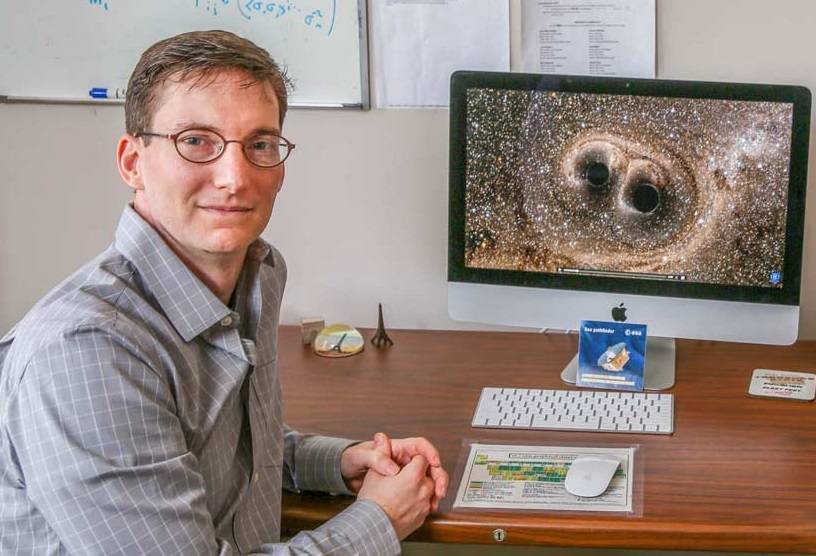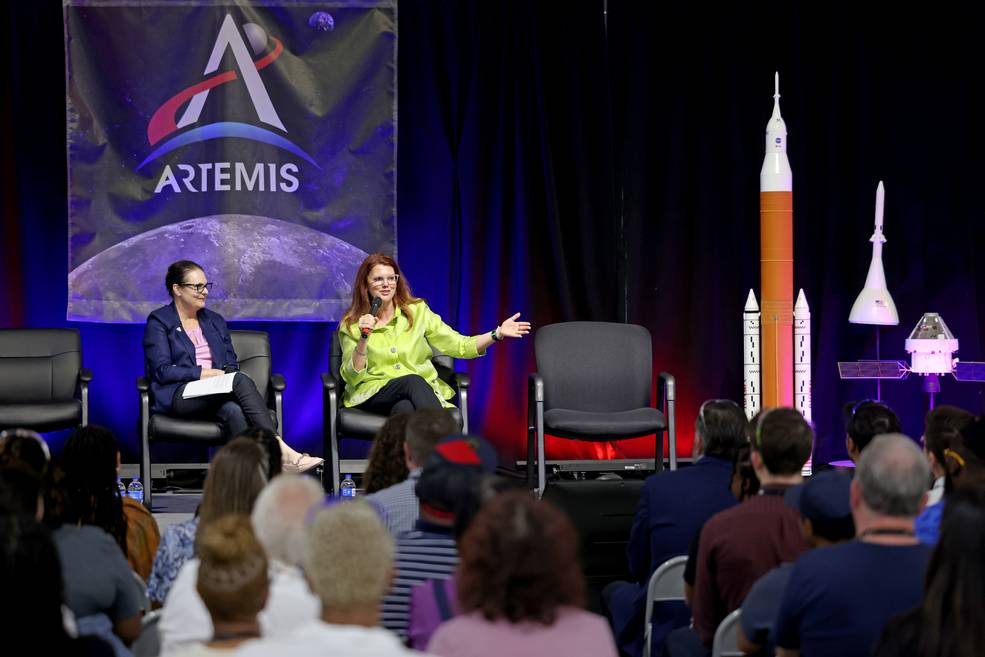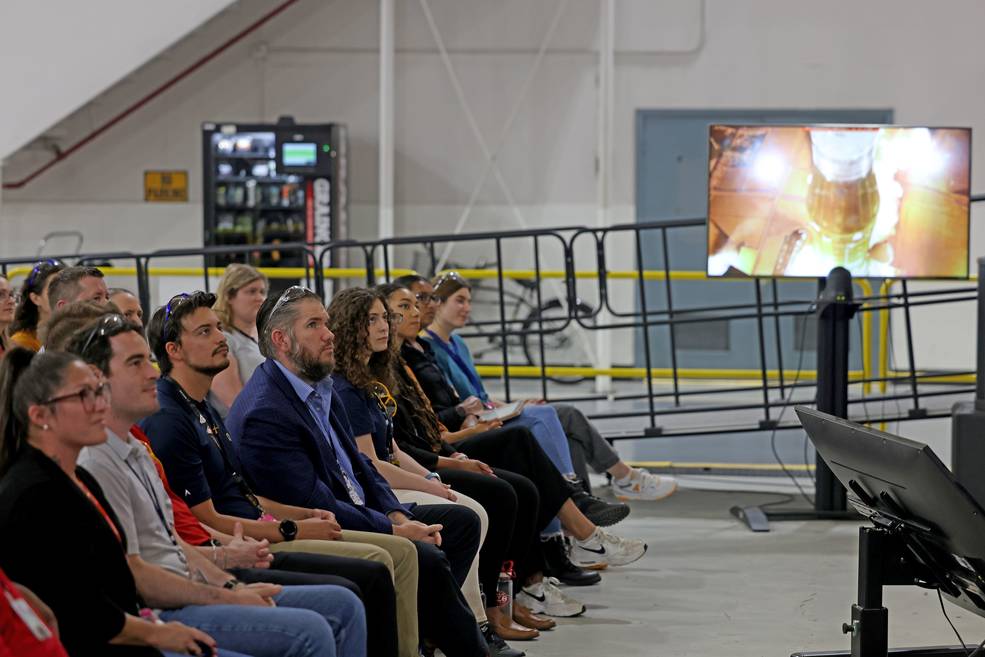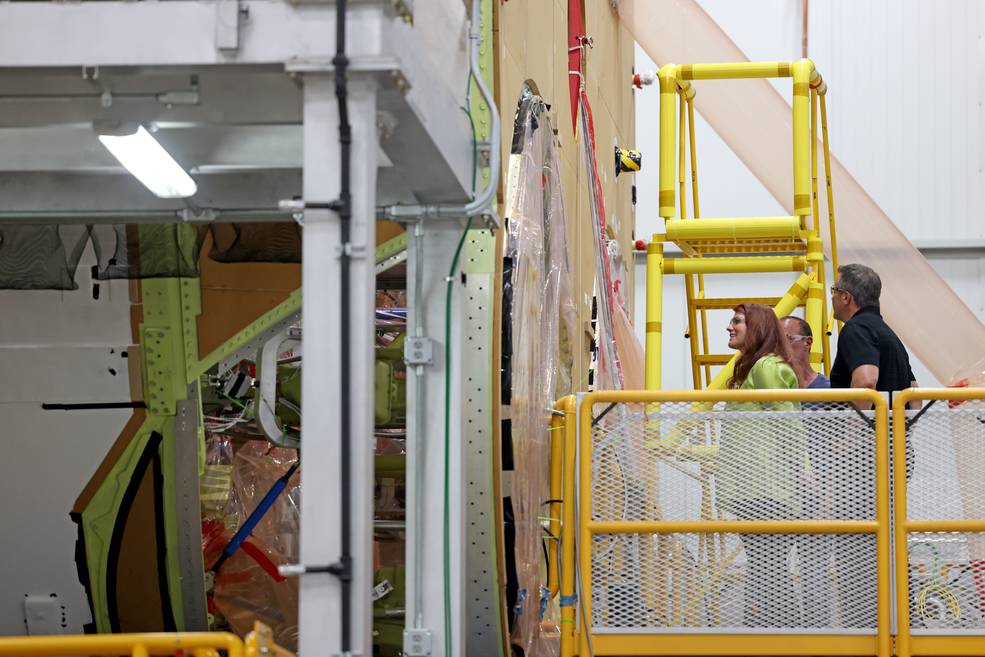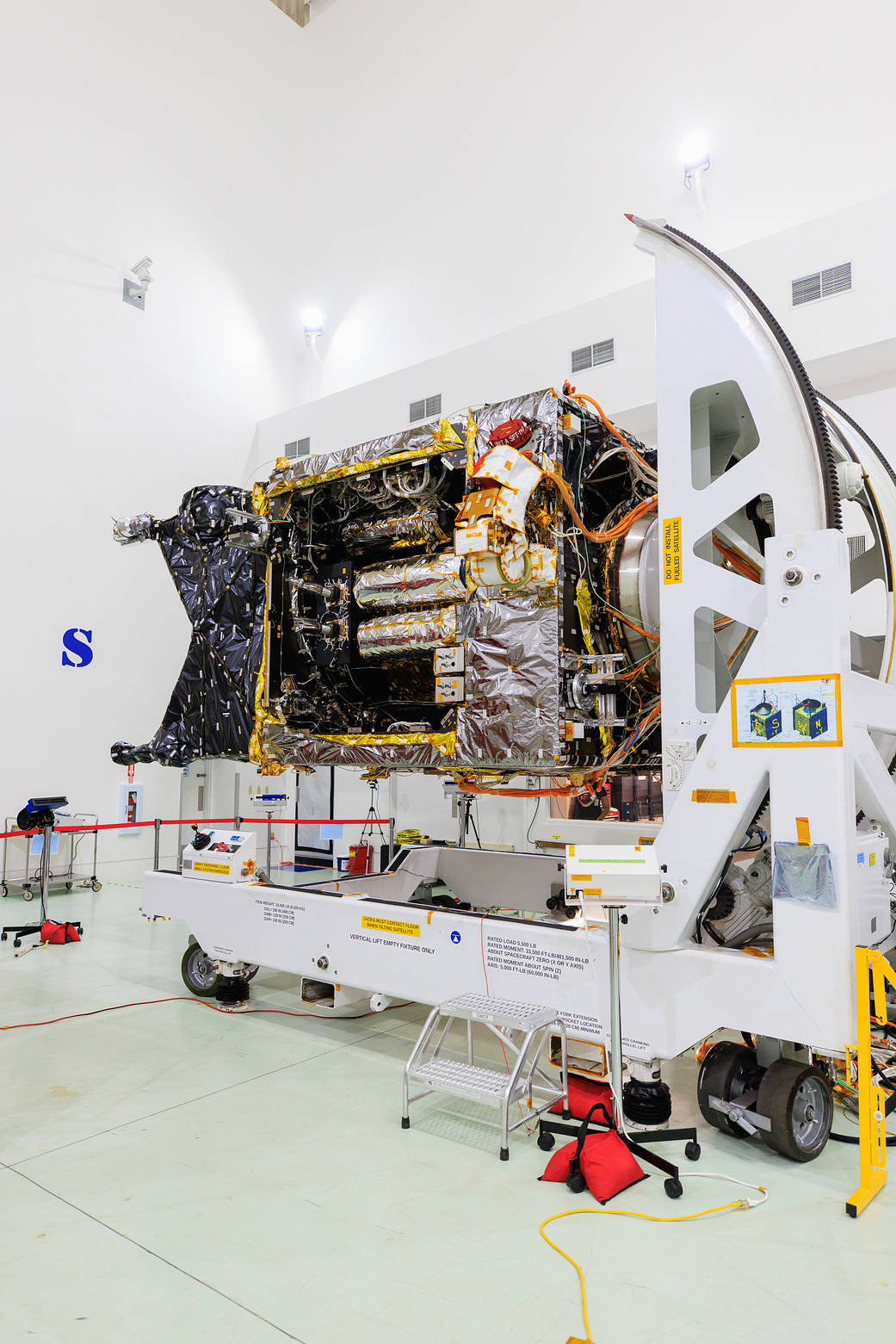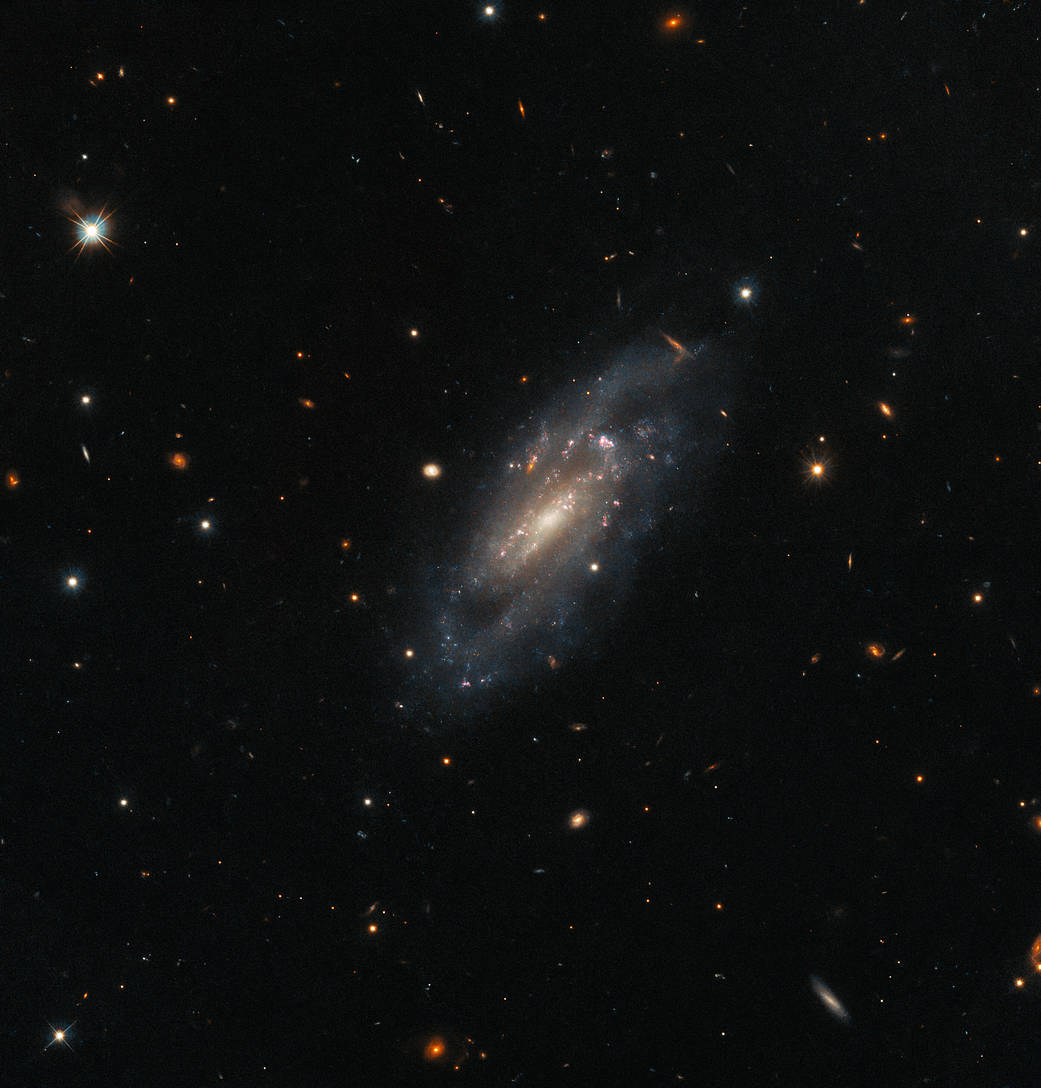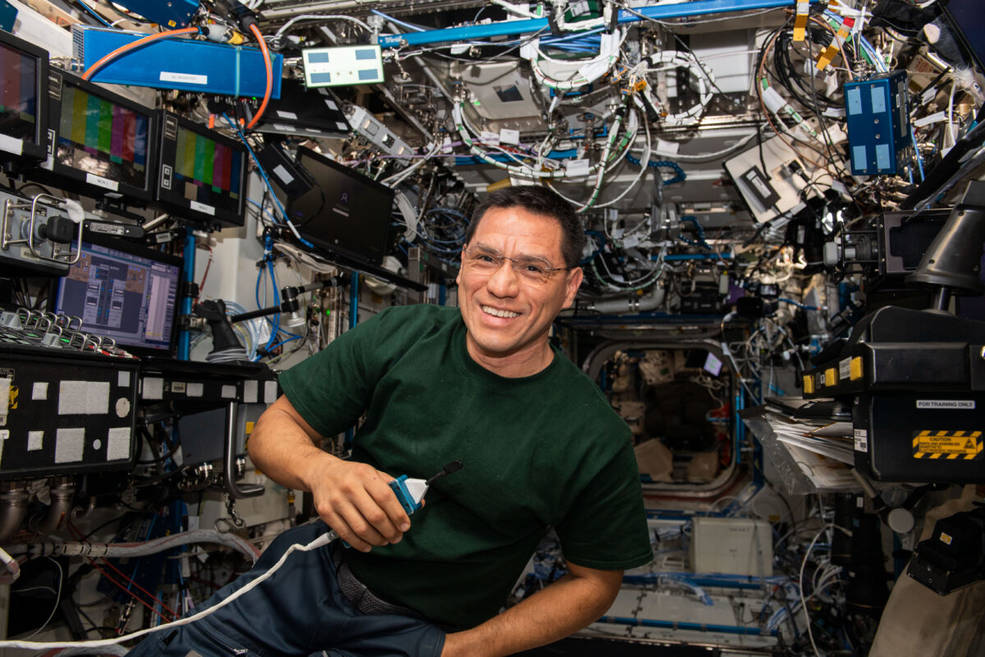The Marshall Star for July 12, 2023.
In This Week’s Star
- Fifteen Years of Radio Data Reveals Evidence of Space-Time ‘Murmur’
- Charlie Blackwell-Thompson Visits Michoud, Thanks Workforce for Artemis I Success
- Webb Celebrates First Year of Science with Close-up on Birth of Sun-like Stars
- Prelaunch Preparations Continue for Psyche Mission
- Hubble Observes a Stunning Spiral
- Space Station Work Includes Clean-up Activities and Ultrasound Scans
Fifteen Years of Radio Data Reveals Evidence of Space-Time ‘Murmur’
Scientists have found evidence of a universal background of gravitational waves, or ripples in the fabric of space-time – and a research astrophysicist at NASA’s Marshall Space Flight Center is contributing to the work.
The motion of black holes and other massive objects through space can create gravitational waves, or ripples in the fabric of the universe. In June, scientists announced the first evidence of a background of long-wavelength gravitational waves that fill the cosmos. These waves are thought to have been created over eons by supermassive black holes, up to billions of times the mass of our Sun, circling each other before they merge.
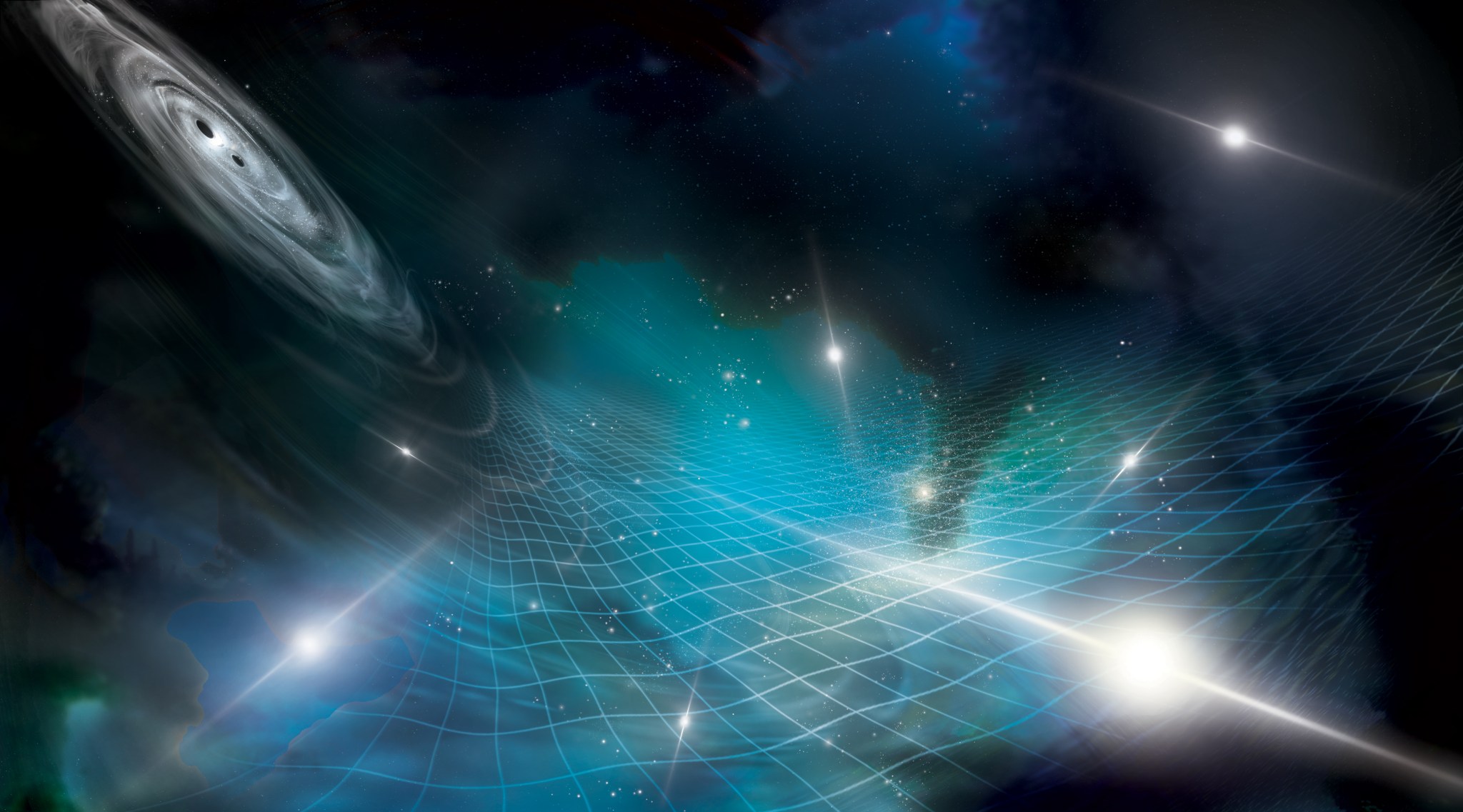
Detecting the gravitational wave background is like tuning in to “the murmuring of the universe,” said Marshall astrophysicist Tyson Littenberg. “Imagine sitting on the 50-yard line at a packed football stadium, surrounded by the tumult of thousands of conversations without being able to distinguish any particular voice.”
That background murmur, detected by The North American Nanohertz Observatory for Gravitational Waves (NANOGrav), will be used to understand astrophysical processes in the universe – including the formation, growth, and evolution of galaxies – which previously were inaccessible to traditional astronomical techniques.
NANOGrav is a coalition of nearly 200 U.S. and Canadian scientists, including researchers at NASA’s Jet Propulsion Laboratory, Marshall, and other NASA centers. The team, which has spent more than 15 years collecting high-precision data from ground-based radio telescopes in order to detect the waves, presented their findings in a series of papers recently published in the Astrophysical Journal Letters.
“Gravitational waves don’t get absorbed or scattered as they move through the cosmos. They just cruise along, passing through everything. Light has a tougher trip, its journey disrupted by cosmic dust, magnetic fields, and other forces,” Littenberg said. “So observing and documenting gravitational waves gives us a brand new way to learn about the composition of our universe, what’s happening to it, and where it’s going in the future.”
These cosmic ripples also could provide new insight into supermassive black hole mergers. Scientists think these mergers happen in most galaxies and influence their evolution but to date have never directly observed the phenomenon.
Gravitational waves initially were predicted in the early 1900s, following Albert Einstein’s 1915 introduction of his General Theory of Relativity. Initially considered a mathematical oddity, the waves were – at that time – impossible to observe or verify.
A century later, the National Science Foundation’s Laser Interferometer Gravitational wave Observatory (LIGO) made the first-ever detection of gravitational waves in 2015. Those signals, at a much shorter wavelength than the new discovery, were from black holes about 30 times the mass of our Sun.
Littenberg, a NASA research astrophysicist since 2016, has pursued gravitational wave studies for most of his career. He earned a doctorate in physics at Montana State University in Bozeman in 2009, followed by post-doctoral research at NASA’s Goddard Space Flight Center and at Northwestern University in Evanston, Illinois.
“When I started, gravitational wave science was still speculative, still theoretical,” he said. “It’s incredibly rewarding now to see the advances made by NASA and our partners across the astrophysics community. What was once a niche area of research is well on its way to becoming a standard part of the astronomer’s toolkit.”
He’s playing a role in developing the next critical tool in that kit – designing data analysis algorithms for the upcoming Laser Interferometer Space Antenna (LISA) mission.
Led by the European Space Agency (ESA) in partnership with NASA, LISA is a future space-based observatory that will detect gravitational waves in a wavelength range between those detected by NANOGrav and LIGO. Researchers will use Littenberg’s algorithms to parse new gravitational wave discoveries. The mission reaches a major milestone this winter when ESA will assess the proposal to make its formal adoption of the ambitious science mission. LISA is expected to launch in the mid-2030s.
“Right now, we’re electrified to be listening to that cosmic murmur,” Littenberg said. “As we continue to grow and refine our detection network, we’ll begin to decipher individual ‘voices’ within the murmur.”
Rick Smith, a Manufacturing Technical Solutions employee supporting Marshall’s Office of Strategic Analysis & Communications, contributed to this story. Read the original article from NASA’s Jet Propulsion Laboratory.
Charlie Blackwell-Thompson Visits Michoud, Thanks Workforce for Artemis I Success
Artemis I Launch Director Charlie Blackwell-Thompson, right, speaks to the Boeing workforce at NASA’s Michoud Assembly Facility during her June 30 visit. Blackwell-Thompson thanked the team for their contribution to the Artemis I mission and emphasized the importance of what they do every day.(NASA/Michael DeMocker)
Boeing employees watch Artemis I launch footage as Blackwell-Thompson recaps launch day. Blackwell-Thompson also spoke about her personal career path, which led to being NASA’s first female launch director, and the importance of mentorships within one’s career.(NASA/Michael DeMocker)
Blackwell-Thompson, left, and Boeing’s Space Launch System Deputy Program Manager/MAF site lead, Steve Snell, right, view the Artemis II core stage during a tour of the factory. In addition to seeing core stage 2, which is being prepared for installation of the four RS-25 engines, Blackwell-Thompson also saw core stages for Artemis III-V in various stages of production at Michoud.(NASA/Michael DeMocker)
Webb Celebrates First Year of Science with Close-up on Birth of Sun-like Stars
From our cosmic backyard in the solar system to distant galaxies near the dawn of time, NASA’s James Webb Space Telescope has delivered on its promise of revealing the universe like never before in its first year of science operations. To celebrate the completion of a successful first year, NASA has released Webb’s image of a small star-forming region in the Rho Ophiuchi cloud complex.
“In just one year, the James Webb Space Telescope has transformed humanity’s view of the cosmos, peering into dust clouds and seeing light from faraway corners of the universe for the very first time. Every new image is a new discovery, empowering scientists around the globe to ask and answer questions they once could never dream of,” said NASA Administrator Bill Nelson. “Webb is an investment in American innovation but also a scientific feat made possible with NASA’s international partners that share a can-do spirit to push the boundaries of what is known to be possible. Thousands of engineers, scientists, and leaders poured their life’s passion into this mission, and their efforts will continue to improve our understanding of the origins of the universe – and our place in it.”

The new Webb image released July 12 features the nearest star-forming region to us. Its proximity at 390 light-years allows for a highly detailed close-up, with no foreground stars in the intervening space.
“On its first anniversary, the James Webb Space Telescope has already delivered upon its promise to unfold the universe, gifting humanity with a breathtaking treasure trove of images and science that will last for decades,” said Nicola Fox, associate administrator of NASA’s Science Mission Directorate in Washington. “An engineering marvel built by the world’s leading scientists and engineers, Webb has given us a more intricate understanding of galaxies, stars, and the atmospheres of planets outside of our solar system than ever before, laying the groundwork for NASA to lead the world in a new era of scientific discovery and the search for habitable worlds.”
Webb’s image shows a region containing approximately 50 young stars, all of them similar in mass to the Sun, or smaller. The darkest areas are the densest, where thick dust cocoons still-forming protostars. Huge bipolar jets of molecular hydrogen, represented in red, dominate the image, appearing horizontally across the upper third and vertically on the right. These occur when a star first bursts through its natal envelope of cosmic dust, shooting out a pair of opposing jets into space like a newborn first stretching her arms out into the world. In contrast, the star S1 has carved out a glowing cave of dust in the lower half of the image. It is the only star in the image that is significantly more massive than the Sun.
“Webb’s image of Rho Ophiuchi allows us to witness a very brief period in the stellar lifecycle with new clarity. Our own Sun experienced a phase like this, long ago, and now we have the technology to see the beginning of another’s star’s story,” said Klaus Pontoppidan, who served as Webb project scientist at the Space Telescope Science Institute in Baltimore, Maryland, since before the telescope’s launch and through the first year of operations.
Some stars in the image display tell-tale shadows indicating protoplanetary disks – potential future planetary systems in the making.
A Full Year, Across the Full Sky
From its very first deep field image, unveiled by President Joe Biden, Vice President Kamala Harris, and Nelson live at the White House, Webb has delivered on its promise to show us more of the universe than ever before. However, Webb revealed much more than distant galaxies in the early universe.
“The breadth of science Webb is capable of exploring really becomes clear now, when we have a full year’s worth of data from targets across the sky,” said Eric Smith, associate director for research in the Astrophysics Division at NASA Headquarters and Webb program scientist. “Webb’s first year of science has not only taught us new things about our universe, but it has revealed the capabilities of the telescope to be greater than our expectations, meaning future discoveries will be even more amazing.” The global astronomy community has spent the past year excitedly poring over Webb’s initial public data and getting a feel for how to work with it.
Beyond the stunning infrared images, what really has scientists excited are Webb’s crisp spectra – the detailed information that can be gleaned from light by the telescope’s spectroscopic instruments. Webb’s spectra have confirmed the distances of some of the farthest galaxies ever observed, and have discovered the earliest, most distant supermassive black holes. They have identified the compositions of planet atmospheres (or lack thereof) with more detail than ever before, and have narrowed down what kinds of atmospheres may exist on rocky exoplanets for the first time. They also have revealed the chemical makeup of stellar nurseries and protoplanetary disks, detecting water, organic carbon-containing molecules, and more. Already, Webb observations have resulted in hundreds of scientific papers answering longstanding questions and raising new ones to address with Webb.
The breadth of Webb science is also apparent in its observations of the region of space we are most familiar with – our own solar system. Faint rings of gas giants appear out of the darkness, dotted by moons, while in the background Webb shows distant galaxies. By comparing detections of water and other molecules in our solar system with those found in the disks of other, much younger planetary systems, Webb is helping to build up clues about our own origins – how Earth became the ideal place for life as we know it.
“With a year of science under our belts, we know exactly how powerful this telescope is, and have delivered a year of spectacular data and discoveries,” said Webb Senior Project Scientist Jane Rigby of NASA’s Goddard Space Flight Center. “We’ve selected an ambitious set of observations for year two – that builds on everything we’ve learned so far. Webb’s science mission is just getting started – there’s so much more to come.”
The James Webb Space Telescope is the world’s premier space science observatory. Webb is solving mysteries in our solar system, looking beyond to distant worlds around other stars, and probing the mysterious structures and origins of our universe and our place in it. Webb is an international program led by NASA with its partners, ESA (European Space Agency) and the Canadian Space Agency. Several NASA centers contributed to the project, including NASA’s Marshall Space Flight Center.
Prelaunch Preparations Continue for Psyche Mission
NASA’s Psyche spacecraft is nearly complete as it rests in a clean room on June 26 at Astrotech Space Operations Facility near the agency’s Kennedy Space Center. Engineers and technicians have begun final assembly, test, and launch operations on Psyche, with assembly of the spacecraft all but complete except for the installation of the solar arrays and the imagers. Psyche is targeted to launch in October. The Psyche mission is under NASA’s Discovery Program, part of the Planetary Missions Program Office at NASA’s Marshall Space Flight Center. (NASA/Frank Michaux)
Hubble Observes a Stunning Spiral
The spiral galaxy UGC 11860 seems to float serenely against a field of background galaxies in this image from the NASA/ESA Hubble Space Telescope. UGC 11860 lies around 184 million light-years away in the constellation Pegasus, and its untroubled appearance is deceiving; this galaxy recently played host to an almost unimaginably energetic stellar explosion. A supernova explosion – the catastrophically violent end of a massive star’s life – was detected in UGC 11860 in 2014. Astronomers used Hubble’s Wide Field Camera 3 to search through the aftermath and analyze the lingering remnants of this vast cosmic explosion. One team explored UGC 11860 to understand more about the star systems that eventually meet their demise in supernovae. The hugely energetic processes during supernova explosions are predominantly responsible for forging the elements between silicon and nickel on the periodic table. This means that understanding the influence of the masses and compositions of the progenitor star systems is vital to explaining how many of the chemical elements here on Earth originated. (Text credit: European Space Agency (ESA). Image credit: ESA/Hubble & NASA, A. Filippenko, J. D. Lyman)
Space Station Work Includes Clean-up Activities and Ultrasound Scans
Four Expedition 69 crew members aboard the International Space Station primarily worked in conjunction July 11 as they completed clean-up tasks and performed ultrasound scans.
After donning the Dreams headband overnight for sleep monitoring, United Arab Emirates (UAE) Flight Engineer Sultan Alneyadi started his day concluding the recording and filling out a questionnaire. Alneyadi, along with NASA astronauts Stephen Bowen, Woody Hoburg, and Frank Rubio, then moved into the orbital lab’s Destiny module for clean-up activities. Tasks included organizing, sorting, and relocating items stowed in the module.
Ahead of clean-up activities, Hoburg spent most of his morning reconfiguring and installing new hardware to a system that recycles and processes wastewater located in the Tranquility module. Bowen collected water samples from the Potable Water Dispenser for in-flight analysis that will help determine the water quality on the station. The system advances water sanitization methods while reducing microbial growth to provide water for crew consumption and food preparation. Rubio set up the Internal Ball Camera—a free-flying system that helps the crew monitor operations—in the Japanese Experiment Module.
Near the end of the day, the quartet moved onto health activities that helps doctors understand how astronauts adapt to microgravity by scanning arteries. Using the Ultrasound 2 device, Alneyadi, Hoburg, Bowen and Rubio all completed ultrasound scans of their necks, clavicles, shoulders, and back of their knees.
Cosmonaut Commander Sergey Prokopyev reviewed and sorted inventory in the Zarya module. Flight engineer Dmitri Petelin completed an experiment that studies the behavior of liquid diffusion in microgravity, while Andrey Fedyaev performed station maintenance.
The Payload Operations Integration Center, located at NASA’s Marshall Space Flight Center, consists of numerous team members who operate, plan, and coordinate the science experiments onboard the space station 365 days a year, 24 hours a day.
Learn more about the space station.


























